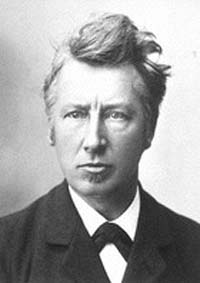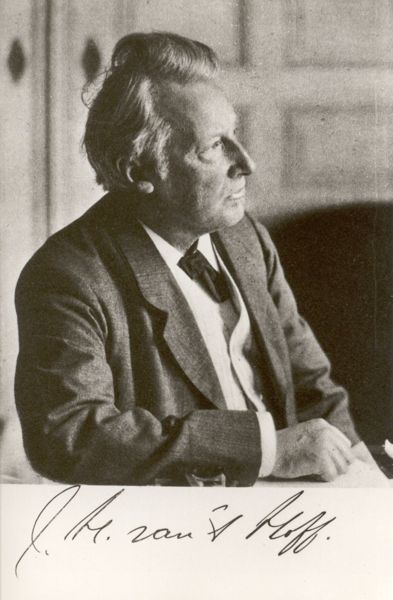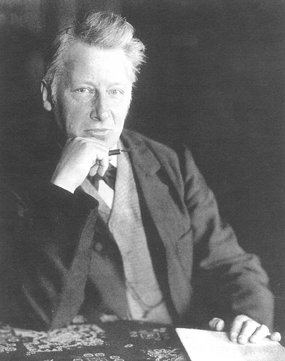<Back to Index>
- Chemist Jacobus Henricus van't Hoff, 1852
- Painter Isaac Ilyich Levitan, 1860
- Shah of the Timurid Dynasty Shāh Rukh Mīrzā, 1377
PAGE SPONSOR



Jacobus Henricus van 't Hoff (30 August 1852 – 1 March 1911) was a Dutch physical and organic chemist and the first winner of the Nobel Prize in chemistry. He is best known for his discoveries in chemical kinetics, chemical equilibrium, osmotic pressure, and stereochemistry. Van 't Hoff's work in these subjects helped found the discipline of physical chemistry as it is today.
The third of seven children, van 't Hoff was born in Rotterdam, the Netherlands. His father was Jacobus Henricus van 't Hoff, a physician, and his mother was Alida Jacoba Kolff. From a young age he was interested in science and nature, and frequently took part in botanical excursions. In his early school years, he showed a strong interest in poetry and philosophy. He considered Lord Byron to be his idol.
Against the wishes of his father, van 't Hoff chose to study chemistry. First, he enrolled at Delft University of Technology in September 1869, and studied until 1871, when he passed his final exam on 8 July and obtained a degree of chemical technologist. He passed all his courses in two years, although the time assigned to study was three years. Then he enrolled at University of Leiden to study chemistry. He then studied in Bonn, Germany with Friedrich Kekulé and in Paris with C.A. Wurtz. He received his doctorate under Eduard Mulder at the University of Utrecht in 1874.
In
1878, van 't Hoff married Johanna Francina Mees. They had two
daughters, Johanna Francina (b. 1880) and Aleida Jacoba (b. 1882), and
two sons, Jacobus Hendricus (b. 1883) and Govert Jacob (b. 1889). van
't Hoff died at the age of 58, on 1 March 1911, at Steglitz near Berlin from tuberculosis. Before he received his doctorate, van 't Hoff had already published the first of his important contributions to the field of organic chemistry. In 1874 he accounted for the phenomenon of optical activity by assuming that the chemical bonds between carbon atoms and their neighbors were directed towards the corners of a regular tetrahedron. This three - dimensional structure accounted for the isomers found in nature. He shares credit for this with the French chemist Joseph Le Bel, who independently came up with the same idea. Van 't Hoff published his work on stereochemistry in his book La chimie dans l'éspace in
1874. At the time, his theory was considered revolutionary and was
strongly criticized by the scientific community. One such critic was
the renowned editor of the German Journal für praktische Chemie, Adolph Kolbe, who stated: A
Dr. H. van ’t Hoff of the Veterinary School at Utrecht has no liking,
apparently, for exact chemical investigation. He has considered it more
comfortable to mount Pegasus (apparently borrowed from the Veterinary
School) and to proclaim in his ‘La chimie dans l’espace’ how
the atoms appear to him to be arranged in space, when he is on the
chemical Mt. Parnassus which he has reached by bold flight. In 1884, van 't Hoff published his research on chemical kinetics, titled Études de Dynamique chimique ("Studies in Chemical Dynamics"), in which he described a new method for determining the order of a reaction using graphics, and applied the laws of thermodynamics to chemical equilibria. He also introduced the modern concept of chemical affinity. In 1886, he showed a similarity between the behaviour of dilute solutions and gases. In 1887, he and German chemist Wilhelm Ostwald founded an influential scientific magazine named Zeitschrift für physikalische Chemie ("Journal of Physical Chemistry"). He worked on Svante Arrhenius's theory of the dissociation of electrolytes and in 1889 provided physical justification for the Arrhenius equation. In 1896, he became a professor at the Prussian Academy of Science in Berlin. His studies of the salt deposits at Stassfurt were an important contribution to Prussia's chemical industry. Van 't Hoff became a lecturer in chemistry and physics at the Veterinary College in Utrecht. He then worked as a professor of chemistry, mineralogy, and geology at the University of Amsterdam for
almost 18 years before eventually becoming the chairman of the
chemistry department. In 1896 van 't Hoff moved to Germany where he
finished his career at the University of Berlin in 1911. In 1901 he received the first Nobel Prize in chemistry for his work with solutions. His work showed that very dilute solutions follow mathematical laws that closely resemble the laws describing the behavior of gases.
In
1885, van 't Hoff was appointed as a member of the Royal Netherlands
Academy of Sciences. Other distinctions include honorary doctorates
from Harvard and Yale (1901), Victoria University, Manchester (1903),
and Heidelberg (1908). He was awarded the Davy Medal of the Royal
Society in 1893 (along with Le Bel),
and the Helmholtz Medal of the Prussian Academy of Sciences (1911). He
was also appointed Chevalier de la Légion d'honneur (1894) and
Senator der Kaiser - Wilhelm - Gesellschaft (1911). van 't Hoff became an
honorary member of the British Chemical Society in London, the Royal
Academy of Sciences in Göttingen (1892),
American Chemical Society (1898), and the Académie des Sciences,
in Paris (1905). Of his numerous distinctions, van 't Hoff regarded
winning the first Nobel Prize in Chemistry as the culmination of his
career.